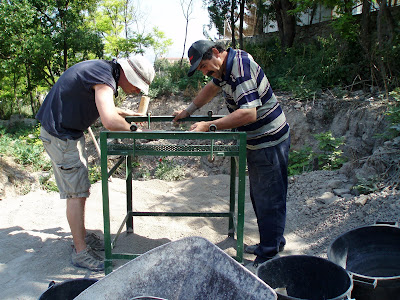
Masters of the Well: Thasos, Panos the Elder, Panos the Younger.
Now, we may have closed the well, but its legacy lives on - piles and buckets of dirt, pottery, enormous quantities of bone, and what archaeology types call ‘small finds.’ To get that pottery and bone and stuff out, however, the soil itself has had to be processed in a variety of ways. Since many of you, oh friends, family,and readers, have not actually been on an archaeological site, I thought the well might actually prove an effective way to explain some of the things that go on hereabouts.

The well. Telos (‘finished’). If you look close, you can actually see my reflection taking the picture.
All the soil that came out of the well has to be dry sieved. That is, all the soil is shaken through a screen to separate the bits of stuff from the dirt This entails bending over in the hot sun for long periods of time, inhaling dirt. I highly recommend sweatbands on the forehead. The process also requires eagle eyes, as the whole point of dry sieving is to catch things that might have been missed when the dirt was first removed - this might be diagnostic pottery, small bones, egg shells, metal objects, glass, etc.

Marty and Vassilis at the dry sieve.
We also collect what is called a flotation sample from each section of the well. A flotation sample is basically a bucket of dirt that is taken to the water sieve, a fancy contrivance that allows archaeologists to collect organic remains.

.JPG)
Corinth's water sieve, designed by Thanos Webb.
All the dirt is poured into a screen that’s in the water – organic remains, like seeds or charcoal, float to the top and are rescued. But all the survivors have to dry before anything else can happen to them, so the little pile of organic stuff is hung out to dry, while the other leftovers, washed clean of dirt, are laid out on plastic.

Then the fun begins. The other residue (heavier material that doesn’t float, like rocks, shells, bones, roof tiles) has to be sorted into boxes according to their size, they have to be weighed, and their volume must be established (Gooooo Water Displacement!).

Sorting flotation material is precise work, done with tweezers, and is probably one of the more exhausting things we have to do; it’s a little hard on the eyes and the back, but its worth it when you get exciting treasures like fish vertebrae. You think I’m joking, but fish vertebrae are cool. Anyways, like I said, it’s rough work and, according to INSTAP’s awesome Archaeological Excavation Manual 1 (Retrieval of Materials with Water Separation Machines), it can best be accomplished by “students and other unskilled individuals (12)”!

Jody Cundy and Marty Wells sort flotation residue, i.e. very very little rocks.
When wells go out of use, they are usually filled up with garbage and junk to prevent unsuspecting infants or puppies from falling in; as they say, one man’s trash is another man’s archaeological treasure. That fill also helps date when the well went out of use. Most of it is dry soil; that is, it’s dry until you hit the water table. Then suddenly the buckets coming out of the well look a little something like this:

Processing this sort of thing becomes a bit more problematic, since it’s too wet to dry sieve and water sieving all of the context takes far too long. We tried laying some of it out to dry on plastic, but ran out of space. My trench partner, Marty Wells, suggested that we ‘water screen’ the mud. Water screening is basically dry sieving, but with a hose spraying water on the soil to wash the silt or mud through quickly.
Of course, bringing a little enthusiasm to the water screening process is equivalent to visiting Wet n’ Wild in the bayou; it’s all water and all mud and all splashing.

If you’re lucky, however, your excavation staff is crafty. And I mean that both in the intelligence sense, and in the arts and crafts sort of way.

Because then you get a lovely nylon dress to wear.
No comments:
Post a Comment